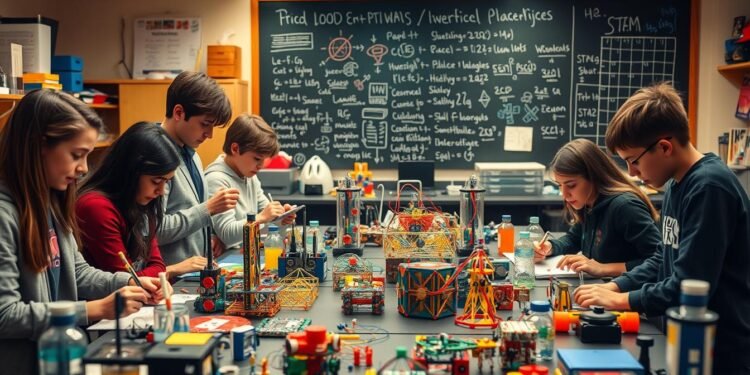Have you ever wondered why some people seem to tackle complex problems with ease? The answer often lies in their ability to think critically and creatively. In today’s fast-paced world, problem-solving skills are more important than ever, especially in STEM fields.
STEM challenges provide a structured way to practice these skills. Whether it’s designing sustainable solutions or optimizing engineering processes, these activities encourage a hands-on approach to learning. They also help individuals understand the process of breaking down problems and finding effective solutions.
From coding competitions to robotics challenges, STEM activities offer real-world applications. They not only build technical expertise but also foster creativity and innovation. This article explores actionable strategies to enhance your abilities through engaging STEM experiences.
Key Takeaways
- Problem-solving skills are essential in STEM and everyday life.
- STEM challenges provide structured opportunities for critical thinking.
- Real-world applications include sustainable design and engineering optimization.
- Hands-on activities like coding and robotics enhance creativity.
- Actionable strategies can help improve problem-solving abilities.
Why Problem-Solving Skills Are Essential in Today’s World
In a world driven by innovation, the ability to solve problems is a game-changer. Whether in personal life or the workplace, this skill opens doors to success. Employers highly value it, with 81% prioritizing problem-solving in their hiring decisions, according to Hays.
Creative thinking leads to innovative solutions, especially in fast-paced industries. Companies like Apple thrive by fostering a culture of design thinking. This approach encourages employees to tackle challenges with fresh perspectives.
The Role of Problem-Solving in Personal and Professional Growth
Problem-solving drives career advancement and leadership opportunities. It equips individuals to handle complex tasks and make informed decisions. In the workplace, this ability is often the difference between success and stagnation.
STEM activities, like building prototypes, simulate real-world challenges. They teach iterative design, mirroring workflows in engineering and tech fields. This hands-on approach builds confidence and practical expertise.
How STEM Challenges Enhance Critical Thinking and Creativity
STEM projects encourage critical thinking and creativity. Activities like robotics and coding require participants to analyze problems and develop effective solutions. This process fosters adaptability and innovation.
Traditional education often focuses on theory, but STEM learning emphasizes practical application. It bridges the gap between classroom knowledge and real-world demands. By engaging in these challenges, individuals sharpen their ability to think outside the box.
Understanding the Foundations of Problem-Solving
Effective problem-solving starts with a clear understanding of the issue at hand. It’s not just about finding quick fixes but addressing the core of the challenge. This approach ensures sustainable solutions that stand the test of time.
One effective framework is the IDEAL model: Identify, Define, Explore, Act, and Look. For example, debugging code involves identifying errors, defining their impact, exploring possible fixes, acting on the best solution, and reviewing the results. This structured process enhances efficiency and accuracy.
Defining Problem-Solving and Its Key Components
To solve a problem, you must first define it clearly. This involves understanding its scope, impact, and underlying factors. Albert Einstein once said, “If I had an hour to solve a problem, I’d spend 55 minutes understanding it and 5 minutes solving it.” This highlights the importance of thorough analysis.
Breaking down the problem into smaller steps makes it more manageable. For instance, in STEM, designing a prototype requires identifying requirements, testing components, and iterating based on feedback. Each step builds toward a comprehensive solution.
The Importance of Identifying the Root Cause
Identifying the root cause is essential for effective solutions. Tools like the “5 Whys” help dig deeper into the issue. For example, if a coffee shop’s tip jar is consistently empty, asking “why” repeatedly might reveal systemic issues like poor customer service.
Superficial fixes, like using a larger bucket to catch leaks, only address symptoms. Systemic solutions, such as repairing the roof, tackle the root cause. This principle applies to STEM challenges, where understanding the core issue leads to innovative breakthroughs.
Avoid common pitfalls like cognitive fixedness, where traditional methods limit creativity. Embracing diverse perspectives and tools ensures a more robust approach to problem-solving.
How to Develop Problem-Solving Skills through STEM Activities
STEM activities are a powerful way to unlock creativity and analytical thinking. These hands-on challenges encourage participants to explore creative solutions while tackling real-world problems. By engaging in structured projects, individuals can refine their ability to think critically and innovatively.
Engaging in Hands-On STEM Challenges to Foster Creativity
Activities like bridge-building contests or robotics projects push participants to think outside the box. For example, designing a solar-powered device requires brainstorming multiple potential solutions. This approach fosters divergent thinking, where ideas flow freely without immediate judgment.
Harvard Business School suggests reframing problems as “How might we?” questions. This technique unlocks innovation by shifting perspectives. Applying it to STEM challenges, such as optimizing a water filtration system, encourages participants to explore unconventional ideas.
Using STEM Projects to Practice Analytical Thinking
STEM projects also emphasize analytical thinking. Data analysis puzzles, for instance, require participants to identify patterns and draw conclusions. This process mirrors real-world scenarios, where solving problems involves both logic and creativity.
Tools like “alternate worlds” encourage cross-industry ideation. For example, applying hospitality strategies to manufacturing challenges can lead to breakthrough solutions. This method enhances the ability to solve problems by leveraging diverse perspectives.
By combining creativity and analysis, STEM activities provide a comprehensive approach to skill development. They prepare individuals to tackle complex challenges with confidence and innovation.
Strategies for Enhancing Critical Thinking in STEM
Critical thinking is the backbone of innovation in STEM fields. It allows individuals to analyze problems, generate ideas, and find effective solutions. By fostering this skill, STEM challenges become a powerful way to prepare for real-world complexities.
Encouraging Open-Ended Questions and Exploration
Open-ended tasks, like designing a Mars habitat, encourage exploration. These challenges push participants to ask questions and think beyond traditional boundaries. For example, SpaceX’s iterative rocket design process shows how open-ended exploration leads to breakthroughs.
Techniques like SCAMPER (Substitute, Combine, Adapt, Modify, Put to another use, Eliminate, Reverse) help reimagine existing solutions. This method fosters creativity while maintaining practicality. It’s a valuable tool for tackling complex STEM problems.
Balancing Divergent and Convergent Thinking in Problem-Solving
Divergent thinking generates a wide range of ideas, while convergent thinking narrows them down. Balancing these approaches is key to effective problem-solving. For instance, 3D printing projects require creativity in design but precision in execution.
Coding challenges teach logical sequencing and error analysis. They combine creativity with analytical thinking, preparing individuals for real-world tech scenarios. This dual approach ensures both innovation and feasibility.
By integrating these strategies, STEM activities enhance critical thinking and problem-solving skills. They provide a structured yet flexible framework for tackling challenges with confidence and creativity.
Building a Problem-Solving Mindset
Building a strong problem-solving mindset requires more than just knowledge—it demands resilience and adaptability. In today’s fast-changing world, being a problem solver means staying flexible and learning from every situation. STEM challenges provide the perfect platform to cultivate this mindset.
Developing Resilience and Adaptability Through STEM Challenges
STEM activities teach individuals to handle setbacks and adapt to new situations. For example, robotics competitions often involve trial and error. Teams must iterate designs, learn from failures, and improve their solutions. This process builds resilience and prepares participants for real-world challenges.
Thomas Edison’s journey to inventing the lightbulb is a classic example. He created over 1,000 prototypes before succeeding. This persistence highlights the importance of adaptability in achieving breakthroughs. STEM challenges mirror this process, encouraging participants to embrace change and keep pushing forward.
Embracing Failure as a Learning Opportunity
Failure is an essential part of growth. NASA’s motto, “Failure is not an option,” contrasts with the real-world reality of trial and error. Post-mortem analysis, like examining bridge collapses, helps engineers understand what went wrong and how to improve. This approach turns failures into valuable lessons.
Classroom strategies, such as “failure journals,” encourage STEM students to document mistakes and reflect on them. This practice fosters a growth mindset, where setbacks are seen as opportunities to learn. By embracing failure, individuals develop the skills needed to tackle complex problems with confidence.
Adaptability is especially crucial in emerging fields like AI ethics and climate tech. These areas require innovative solutions and the ability to navigate uncertainty. STEM challenges prepare individuals to thrive in such dynamic environments, making them better problem solvers in the long run.
Practical Tips for Implementing STEM Challenges
Implementing STEM challenges effectively requires a blend of strategy and collaboration. These activities not only enhance technical skills but also foster a culture of innovation and teamwork. By creating the right environment and encouraging open communication, participants can thrive and achieve meaningful results.
Creating a Supportive Environment for Experimentation
A supportive environment encourages participants to take risks and explore new ideas. Tools like Trello can help make group engineering projects more manageable by organizing tasks and deadlines. Role-playing in STEM labs, such as assigning project manager or engineer roles, also promotes accountability and collaboration.
Safe and inclusive workspaces are essential for fostering creativity. Providing a checklist for lab safety ensures that all team members feel secure while experimenting. This approach not only boosts confidence but also allows participants to focus on solving problems without unnecessary distractions.
Incorporating Teamwork and Communication Skills in STEM Activities
Effective teamwork is crucial for tackling complex challenges. Techniques like “Yes, and” improvisation, as highlighted by Harvard Business School, boost collaborative ideation. Teaching active listening through case studies, such as Pfizer’s vaccine development team, enhances communication skills and ensures everyone’s voice is heard.
Conflict resolution is another key aspect. Using Agile methodologies in coding teams helps address disagreements constructively. By focusing on the root cause of conflicts, teams can find sustainable solutions and maintain productivity. These strategies ensure that STEM activities are not just about technical skills but also about building strong, cohesive teams.
By integrating these practical tips, STEM challenges become a powerful way to develop both technical and interpersonal skills. They prepare individuals to work effectively in dynamic, real-world environments.
Conclusion
Mastering problem-solving is a journey that combines strategy, creativity, and persistence. Key strategies like root cause analysis, iterative design, and collaborative learning are essential for tackling complex challenges. These approaches not only build technical expertise but also foster a mindset geared toward innovation.
Enrollment in courses like Coursera’s “Design Thinking and Innovation” has surged by 200% since 2020, reflecting the growing demand for these skills. Such programs equip individuals with the tools to become effective problem solvers, ready to address future trends like quantum computing and bioengineering.
STEM activities provide a practical way to apply these solutions in real-world scenarios. By joining local STEM clubs or participating in online challenges, you can enhance your thinking and problem-solving abilities. Take the first step today and unlock your potential in the ever-evolving world of STEM.
FAQ
Why are problem-solving skills important in today’s world?
Problem-solving skills are crucial for personal and professional growth. They help individuals tackle challenges, make informed decisions, and adapt to changing situations. In the workplace, these skills enhance productivity and innovation.
How do STEM challenges improve critical thinking and creativity?
STEM challenges encourage hands-on learning and experimentation. They push individuals to think critically, explore alternative solutions, and apply creativity to solve complex problems effectively.
What are the key components of problem-solving?
Problem-solving involves defining the issue, identifying the root cause, brainstorming potential solutions, and implementing the best strategy. It also requires evaluating outcomes and learning from the process.
Why is identifying the root cause of a problem essential?
Identifying the root cause ensures that solutions address the core issue rather than just its symptoms. This approach leads to more effective and long-lasting results.
How can STEM activities help develop problem-solving skills?
STEM activities provide practical scenarios where individuals can practice analytical thinking and creativity. They offer opportunities to experiment, fail, and learn, fostering a growth mindset.
What strategies enhance critical thinking in STEM?
Encouraging open-ended questions, promoting exploration, and balancing divergent and convergent thinking are effective strategies. These methods help individuals approach problems from multiple angles.
How can STEM challenges build resilience and adaptability?
STEM challenges often involve trial and error, teaching individuals to embrace failure as part of the learning process. This builds resilience and adaptability, essential traits for problem-solving.
What are practical tips for implementing STEM challenges?
Create a supportive environment for experimentation, encourage teamwork, and integrate communication skills. These elements ensure a collaborative and effective learning experience.









